Tagged with 'Buying pearls'


-
Choosing the Perfect Pearl Stud Earrings
Choosing the Perfect Pearl Stud Earrings
Pearl stud earrings are perhaps the simplest, and yet prettiest, of all earrings and should be an essential item of any jewellery box. At quick glance, pearl earring studs may appear all the same. Before looking at our new collection of pearl stud earrings, here is our short guide to choosing and buying the perfect pearl studs.
THE LUSTRE OF A PEARL
The magic of a pearl lies hidden within its surface, where layers of a mother-of-pearl material called nacre gives this unique gem its characteristic shine or lustre. The stronger the lustre of a pearl, the more beautiful it will be. Above all else, choose a pearl stud earring that has excellent lustre.
THE SIZE OF THE PEARL
Pearls vary in size considerably and this does alter the style of the earring itself. The size of a round pearl is measured in millimetres across its diameter. Smaller pearls up to 8mm in diameter are easily worn every day and tend to be favoured by women with more petite features. Earring studs with pearls over 8mm in diameter can be ideal for evening wear and for special occasions.
If in doubt, we recommend choosing pearl earring studs around 7.5-9 mm in diameter, which are most likely to suit all styles and are sufficiently versatile to be able to dress up or down with.
PEARL SHAPE AND SURFACE
A pearl earring should have a clean surface, with very few visible marks, unless the pearl is asymmetrical or baroque shaped. The majority of pearls used for stud earrings are round or button shaped. Button shaped Freshwater pearls can give an attractive twist to the classic pearl earring stud as they can also easily be worn in larger sizes.
With our jewellery, we love the lustre, quality and round shape of the Akoya pearl as a perfect choice for pearl stud earrings. If you would like to learn more, read about Choosing and Wearing Pearl Earrings and Choosing Pearl Earring Backs in our Journal.
Discover our new collection of stud earrings for women here. -
Jewellery Ideas for Visitors to London
Jewellery Ideas for Visitors to London
One of the largest and most vibrant capital cities in the world, London is filled with brilliant jewellery ideas and destinations for culture lovers and shoppers alike. To help you navigate some of the treasures dotted around the city, here is a short jewellery guide to the city with five favourite places to visit.
FOR THE HISTORY LOVER
The Tower of London and Buckingham Palace are two of the most popular royal palaces for visitors to the city. In time for the Jubilee and the Olympics, a recent new exhibit at The Tower of London explores the role of the Crown Jewels and the story of the Tower in protecting these treasures.
The Imperial State Crown is an undisputed highlight of the extraordinary jewels on display and is worn by the Queen at the annual State Opening of Parliament. Set with sapphires, rubies and pearls, the crown also features one of the most famous diamonds in the world. If you are visiting Buckingham Palace in 2012, do not miss the story of the Cullinan Diamond in the new exhibition there.
FOR THE BUDDING GEMOLOGIST
The Vault at the Natural History Museum is a treasure trove for anyone interested in gems and gemmology. Discover its gallery of celestial meteorites, the 1,383.93 carat Devonshire Emerald, pure gold crystals and a diamond the size of an egg.
FOR THE ROMANTIC
The Linnean Society of London is the world’s oldest active biological society and, situated away from the bustle of Piccadilly, quietly hides a secret for pearl lovers. Founded in 1788, the Society takes its name from the Swedish naturalist Carl Linnaeus, who produced the world's first spherical cultured pearl.
Linnaeus grew his spherical pearls in freshwater mussels by drilling a small hole in the shell and inserted a tiny granule of limestone between the mantle and the shell of the mussel. The mussels were returned to their river and over six years covered the implanted material with nacre to make a cultured pearl. A set of these experimental ‘Linnaean pearls’ is held by the Society amongst the Linnean Shell collection.
FOR THE SHOPPER
If you are interested in browsing the best of jewellery design, London has so much to offer.
Historically Hatton Garden has been the main district of the jewellery trade in London. The area is now undergoing a resurgence as a home to independent designers and the new Goldsmith's Centre, a purpose built facility for promoting the best in creativity and craftsmanship.
Setting the fashion trend, Liberty’s may be the ultimate destination, offering contemporary jewellery from designers in a iconically British building fashioned from the timbers of two Royal Navy warships.
For luxury brands such as Asprey, Boodles, Bvlgari, Cartier, Mikimoto, Tiffany and others, the streets of Mayfair, and in particular Bond Street, Mount Street, South Molton Street and the Burlington Arcade, are the place to be seen.
-
A Guide to Buying Jewellery Online
A Guide to Buying Jewellery Online
"This was the first time that I have ordered jewellery online". Online shopping for luxury goods continues to grow in the UK as customers embrace choice and convenience, but this comment from one of our recent happy customers is perhaps a good reminder of just how personal choosing a piece of jewellery can be.
We are always thinking about how we can improve the experience of buying pearls online at Winterson. Over the next months, we will be introducing a number of exciting changes to our website including high definition video of our favourite pieces of pearl jewellery. We love the way that these images show off the subtle beauty of the different types of pearls.
Here is a short guide to some of the other key questions that you may wish to consider before buying jewellery online.
WILL I RECEIVE WHAT I ORDER?
Whilst beautiful photography can help showcase a piece of jewellery, a good description is also worth seeking out. Pearls, in particular, are an organic gem formed in a mollusc and their quality can vary considerably. We believe strongly in disclosing the quality grading of all our pearl jewellery, including a pearl's size, its lustre and whether it has been treated for colour. If you have a question regarding our pearls, please do contact us and we would be delighted to help.
IS A WEBSITE SAFE TO USE?
Shopping online is generally safe and many online sellers today, including Winterson, do not store their customer's credit card details. Instead most online retailers use a secure online payment service to process the transaction. Always check to see if:
- the website uses an organisation such as Sagepay to process their card transactions
- that the address at the top of your browser window shows a padlock or https:// to indicate that a secure, encrypted connection has been established
CAN I RETURN THE JEWELLERY?
We understand that sometimes the jewellery may not be suitable or, if given as a gift, may wish to be exchanged. By law in the UK, shoppers buying goods online have 7 days from taking delivery to return the goods to the seller. This includes earrings. At Winterson, we offer our customers 14 days from the date of delivery to return your jewellery to us for any reason, excluding any items of a bespoke nature. This is a free service for our customers in the UK.
WHAT DO OTHERS THINK?
Finding out what others think of an online retailer is a sensible question to ask, but not every review site online is able to guarantee that the reviews displayed there are from genuine customers. Every customer at Winterson receives a follow-up email from Feefo, an independent organisation that allows our customers an opportunity to let us know how we are doing. These independent reviews can be found here. If you purchase jewellery online from us and receive one of these emails, please do give us your feedback on our pearl jewellery and our customer service.
To help with any other decisions or general questions that you may have regarding jewellery online, we recently introduced a Frequently Asked Questions page to the website. If you also missed our earlier Journal article on the ten questions to ask when buying pearl jewellery, then you can find it here.
-
Measuring and Choosing a Pearl Size
Measuring and Choosing a Pearl Size
One important factor in designing pearl jewellery is the size of the pearl itself. Pearl size can have an immediate impact on the aesthetic look of the jewellery, its technical design as well as defining which types of pearl may be used and the value of these.
How should pearl size be measured and what should you look for when choosing pearl jewellery?
MEASURING A PEARL'S SIZE
We grade pearls in accordance with a system proposed by the Gemological Institute of America, the body that introduced the 4Cs grading system for diamonds. This grading information is disclosed on each product page of the Winterson website. Pearl Size is one of the 7 value factors recommended by the GIA when grading a pearl.
Measuring a round pearl is relatively simple. The diameter is usually measured and given to the nearest 0.5th millimetre. Other shapes of pearls, for example, drop or baroque-shaped pearls, are harder to size in the same manner and so two dimensions are usually given: the width and the height of the pearl, again to the nearest 0.5th millimetre.
The smallest pearls are called seed pearls, which can be as tiny as 1 millimetre in diameter, whilst the largest pearls commercially available can reach 2 centimetre in diameter and are produced in large South Sea oysters.
FACTORS THAT INFLUENCE A PEARL'S SIZE
For a bead nucleated cultured pearl, the eventual size of the pearl will be determined by the size of shell nucleus used by the pearl farmer to help stimulate the production of the pearl, the health of the mollusc and how long the pearl remains in the mollusc to grow.
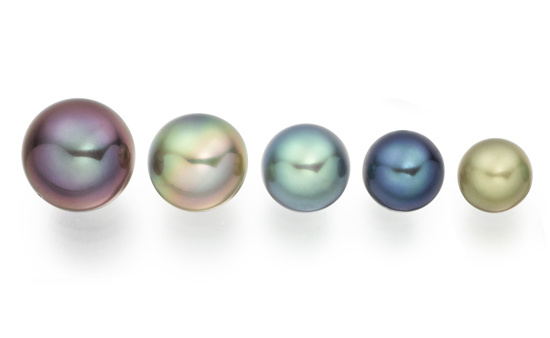
The size of the pearl can also give away a lot of clues about a pearl. For example, it is unusual today to find a white Akoya cultured pearl that is greater than 10mm diameter due to the size of its saltwater oyster host.
Similarly, most round Tahitian and South Sea cultured pearls are generally only found in sizes greater than 8mm, with a few reaching more than 18mm in rare instances.
CHOOSING THE RIGHT SIZE OF PEARL
Choosing the right size of pearl is mostly a matter of personal preference and budget. The smallest seed pearls can look as if they should be decorating a piece of royal or antique jewellery. In contrast La Peregrina, one of the best known natural pearls, was recently sold at auction for almost $12million and measured an incredible 17.5mm by 25.5mm.
The most popular sized pearls tend to be in the 7-9mm diameter range as this is a good, easy-to-wear size for necklaces and earrings. In general terms, a smaller pearl might suit a younger woman or slighter frame better, whilst a larger pearl over 9mm can be more contemporary in its style, luxurious and powerful as a statement.

Most of our Freshwater and Akoya pearl jewellery is made with pearls that are 7-9mm in diameter and our Tahitian and South Sea pearl jewellery with pearls that are 9-13mm in diameter.
If you are hesitating between pearl sizes, consider your body frame, the occasions on which you would like to wear the pearl jewellery and your budget. A simple trick may be look into your jewellery box and measure other jewellery you already wear.
MATCHING PEARL JEWELLERY
A contemporary pearl set will usually have pearls of the same size and shape and colour, as in our Classic Akoya Pearl Necklace, Bracelet and Earring Set. The exquisite consistency of size, shape and colour of the pearls gives a sense of symmetry, perfection and beauty to the jewellery.
Pearl jewellery sets though do not have to have pearls of same size and shape to look amazing. Try a drop-shaped pearl pendant with a pair of earrings studs for a classic style, also favoured by brides.
The simplest advice if you are matching a new piece of jewellery with some existing pearls, would be to keep the variation within 1-2mm of diameter difference. As the ‘piece de resistance’, a necklace will also typically have larger pearls than a matching pair of earrings or bracelet.
NEED MORE HELP?
We choose the pearl size that we feel will most elegantly match the design of our jewellery.
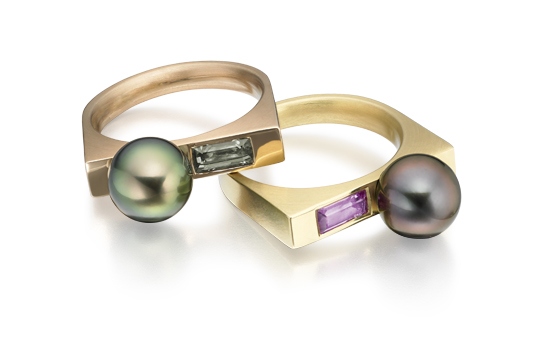
If you have any questions regarding the size of our pearls, or choosing a piece of pearl jewellery, please Contact Us and we would be delighted to assist you.
-
An Introduction to Pearl Colour
An Introduction to Pearl Colour
One of the most beautiful and unique qualities of a pearl is its colour. The popular image of a cultured pearl is that it should be pure and white, but there are many more types of pearls with natural, and quite unnatural colours. What determines a pearl's colour, how is pearl colour graded by an expert and what should you look for when buying pearls?
WHAT CAUSES A PEARL'S COLOUR?
The physical colour of a pearl is influenced by a number of factors. The colour of the host mollusc's shell, and the genetic fingerprint of its tissue and epithelial cells, gives the greatest clue to a pearl's eventual colour. A classic Akoya pearl, for example, will have a neutral white body colour similar to the shell colour of its oyster and a Tahitian pearl will have the dark tones of the black-lipped Pinctada margaritifera cumingii oyster. Although pearl farmers and scientists have tried to influence the colour of a cultured pearl through the selection of a small piece of mantle tissue for pearl grafting, the specific pearl colour remains somewhat of a mystery until the pearl is fully formed.
The quality of a mollusc's environment can influence its colour and is one reason why pearl farmers are increasingly focused on raising marine environmental awareness. The quality and nutritional content of water directly affects an mollusc's health, its growth rate and the quality of the nacre it produces. If the nacre of a pearl is very thin or of poor quality, the colour of the pearl will appear matt and lack overtones. The striking metallic bronze and green colours of some natural American freshwater pearls, for example, are believed to be a result of trace elements such as copper in the local water systems.
There are many shades of colour-treated pearls available today, including Black Freshwater and Akoya, Grey and Peacock Freshwater pearls, Chocolate, Cherry and Rose. Each of these unnatural colours will have been the result of a colour treatment after the pearl has been cleaned. Some colour treatments such as bleaching and applying a pink tint are so widely used that they are rarely disclosed. Other more significant post-harvesting treatments, however, might include immersion in silver nitrate and irradiation to lighten or darken a pearl's colour.
GRADING PEARL COLOUR
The pearl industry and pearl lovers alike commonly use a variety of terms such as gold, pistachio, lavender to help describe the colour of a pearl. To help standardise how pearls are graded, The Gemological Institute of America (GIA), which led the way in establishing a classification system for diamonds, introduced Color as one of its seven key criteria for grading the quality of pearls.
An expert will assess the colour of each pearl according to a description system that uses 19 different cool and warm colour hues.
Each pearl should have the following three characteristics described, where applicable:
- Bodycolour – the dominant, overall colour of a pearl
- Overtone – some pearls display one or more additional overtones of colour in the reflection near the top of a pearl
- Orient – the rainbow colours that are displayed just below the surface of a pearl, usually those of a baroque shape, as it is rotated
As well as having many years of experience with pearls, the team at Winterson is trained in pearl grading by the GIA. Pearl Colour is one of the value factors that we use to describe the pearl jewellery at Winterson. If you would like to know more about the quality of our pearls, or how we grade them, please do contact us.
WHAT TO LOOK FOR
In our experience the most popular colour of pearls is still white, perhaps matched with the sparkle of a diamond. There are more choices of types of pearl available in this colour, that the size of pearl and an individual's budget start to be a significant decision factor.
The pastel shades of freshwater pearls are beautiful for wearing in the summer. The darker exotic shades of Tahitian pearls are contemporary in style and very elegant for business and evening wear.
Some dyeing treatments can be identified if the pearls are uniformly one colour or at the drill hole where it may be possible to see some residue of dye. A darker nucleus inside the pearl may also be evidence of irradiation treatment. If you are concerned about a pearl's colour, ask your jeweller and look for proper disclosure of colour and other grading factors when buying pearls.
-
Pits, Chips and Bumps on the Surface
Pits, Chips and Bumps on the Surface
Look closely at this image of these beautiful baroque Tahitian pearls and it is possible to see several small blemishes and imperfections on the surface of the pearl. Although fake pearls are typically very smooth and artificially perfect, a real pearl may often have irregularities such as pits, chips, bumps and scratches on its surface.
Both natural and cultured pearls are formed by a mussel or oyster over months and even years. Because of this slow process, it is rare for the surface of a pearl to be perfectly flawless and instead it can be quite normal for pearls to have blemishes on their surface. Baroque Tahitian pearls such as these pictured are loved for their individual beauty. Some pearls such as colourful freshwater Kasumi pearls from Japan are known for their distinctive wrinkles on their surface.
The surface of a pearl can range from being spotless to being very heavily blemished. Tiny spots of conchiolin or aragonite, two components of a pearl's nacre, can be minor and may even add character to the gem. Other flaws such as cracks, patches of thin nacre or a strong discolouration of the pearl surface are best avoided. We are very careful to select pearls that are not disfigured in this way or where their longevity may be in question.
Due to their rarity in any harvest, the fewer and smaller the flaws that a pearl has, the more valuable a perfect pearl will typically be. When buying pearls, it can be easy to focus on minor blemishes on a pearl's surface and to ignore other important factors such as lustre. Often small blemishes can also be hidden from view by the jeweller in the setting or the drill hole.
The Gemological Institute of America (GIA) established one of the leading gemological systems for grading the quality of pearls according to 7 key criteria: size, shape, color, luster, surface quality, nacre quality and matching.
To classify the condition of the surface of a real pearl, an expert will assess and grade the surface of the majority of pearls as:
- Clean – Pearls are blemish-free or contain minute surface characteristics
- Lightly Spotted – Pearls show minor surface irregularities
- Moderately Spotted – Pearls show noticeable surface characteristics
- Heavily Spotted – Pearls show obvious surface irregularities
As well as having many years of experience with pearls, the team at Winterson is trained in pearl grading by the GIA. A pearl's surface is one of the value factors that we use to describe the pearl jewellery at Winterson. The baroque Tahitian pearl necklace pictured in this image has a surface grading of Clean to Lightly Spotted and this is fully disclosed on the Winterson website.
If you would like to know more about the quality of our pearls, or how we grade them, please do contact us.
-
Roaring Twenties Fashion for SS 2012
Roaring Twenties Fashion for SS 2012
If you enjoyed the recent nostalgia of The Artist, the catwalk fashions for Spring/Summer 2012 look to continue the revival of the Roaring Twenties, with drop waist dresses, crisp whites, relaxed pastels and glamorous drapes of pearls.
The 1920s were prosperous years between two world wars that saw a wave of social, cultural and technology developments. Art Deco styling led the design world with clean geometrical lines and contrasting colours of black, white and gold, inspired by the Ancient Egyptians and the Aztecs. In New York, the Empire State Building and the Chrysler Building are still two of the most emblematic buildings of their time. Technology breakthroughs such as radio, cinema ‘talkies’ and the automobile brought a new and popular sense of freedom.
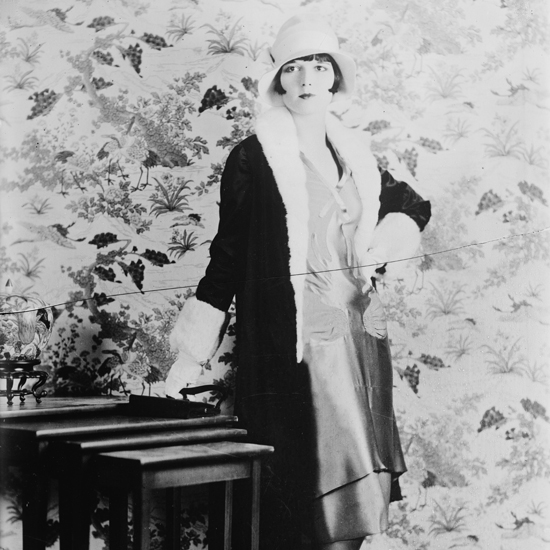
In the fashion world, young women cast aside decades of Victorian fashion and restraining corsets to express their independent and modern aspirations. Detail that was influenced by Art Deco, with zigzags and geometrical shapes, was also however about comfort. Knee-length skirts, drop waist dresses, low necklines with exposed arms and wrists by iconic designers such as Coco Chanel and Elsa Schiaparelli were characteristic of the time. Feathers, tassels and silk added a fluid and deliberately flirtatious appearance.
Cultured pearls were the gem of the decade. Long white pearl necklaces were wrapped and often layered around the neck, enhancing the low necklines. These chic pearl sautoirs would swing with movement and dancing. Earrings and drop earrings sat visibly below bobbed haircuts and pearl bracelets decorated bare arms and wrists.
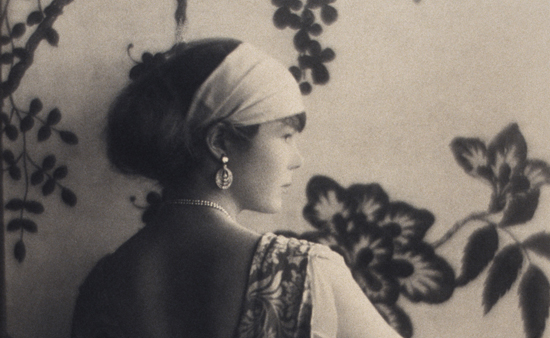
Nearly a century on, the iconic Roaring Twenties that was depicted by F. Scott Fitgerald in The Great Gatsby is still inspiring designers today. In sharp contrast to today's mood of austerity, the Spring/Summer 2012 collections of Ralph Lauren and Gucci reference this seductive era of glamour with fluid lines, slim silhouettes, cloche hats, silk, feathers, drop earrings and of course swinging long white pearl rope necklaces.
With a Gatsby film adaptation also due later this year, you could be forgiven for thinking it’s the 1920s again. There may not be the same rebellious energy of the flapper driving automobiles, listening to American jazz and attending glamorous parties but we love its look and confidence.
-
The Lasting Allure of Gold Jewellery
The Lasting Allure of Gold Jewellery
The steady rise in the price of gold over the last five years shows an enduring fascination with this precious metal. Tutankhamun's mask, King Midas, our coinage systems, Eldorado, the Californian gold rush and even James Bond's arch rival Goldfinger are some of the icons of wealth and greed that this noble metal has helped create throughout history. What is the lasting allure of gold and its use in gold jewellery today?
Gold is a metal with remarkable properties for use in jewellery. It is a dense and durable metal being resistant to corrosion and oxidation, yet can be soft and malleable for the making of jewellery. Gold also conducts heat well and rapidly warms to our body temperature. In its purest form, gold has a bright mesmerizing yellow colour that has a sensual beauty next to the skin.
The purity of gold is defined in units of carats, which is believed to be derived from a Roman coin called a solidus that was introduced by the Emperor Diocletian around 300AD. Each coin struck had around 24 carats of gold and this sub-division continues today.
24 carat gold is the purest form of gold, with 999 parts per thousand of gold, and is generally regarded as being too soft for jewellery. To increase the metal's hardness, gold is combined with other metals to form an alloy. 18 carat gold, for example, is composed of 18 parts of pure gold and 6 parts of another metal. 14 carat and 9 carat gold have decreasing parts of pure gold and therefore are less valuable.
The alloying process also allows a jeweller to introduce other metals to influence the final colour of the alloy. The colour of pure gold is yellow, but with the addition of a metal such as palladium, the alloy will turn a silvery white that is sold with the finesse of 18 carat white gold. Alloys made with nickel and gold have been phased out in Europe since 2000 to help prevent the incidence of allergies. Other colour golds such as rose gold can be achieved with a gold alloy containing copper.
Gold is very resistant to wear and it will retain its shape and colour for generations. Most white gold jewellery sold today is also plated with rhodium, a platinum-like metal that gives white gold an additional gleam. This will start to wear within 2 to 3 years, but can be easily replaced at most jewellers.
To care for your gold jewellery, clean the gold with a soft cleaning cloth with a good quality cleaning liquid. Polish the metal with gentle, circular movements and dry off any excess liquid. Be careful however not to damage any more sensitive gems such as pearls and, if in doubt, simply clean and polish your gold jewellery with water.
As gold prices have increased, more jewellery with a lower gold finesse or silver has become popular. At Winterson, we favour 18 carat gold for its lasting value, quality and durability and all our gold jewellery is hallmarked at the London Assay office to verify its gold content. We design with either yellow or white gold to match with our Freshwater, Akoya and South Sea pearls, whilst Tahitian pearls with their dark colours have a more contemporary partnership with 18 carat white gold.
-
Buy a Pearl Annually for a Pearl Necklace?
Buy a Pearl Annually for a Pearl Necklace?
We were asked recently if it might be possible to buy a pearl every year and collect these to make into a pearl necklace, perhaps as a gift for a new baby daughter to wear on her 18th or 21st birthday.
Buying plans for individuals to purchase loose cultured pearls over a lengthy period of time used to be quite popular. There are still several examples that can be found on the internet today for buying single Akoya pearls.
As the increased availability of freshwater pearls from China has made pearls more widely affordable, these collecting schemes have been in less demand.
Also, one other concern is that when making a piece of jewellery, it is important to choose pearls that match each other, for example in size, shape or colour. You would need to be confident that all of the pearls bought each year would match when the time came for the necklace to be strung.
Instead of buying a series of individual pearls, our advice would be to:
- Buy a finished pearl necklace or piece of jewellery and keep it safely until the time of the 18th or 21st birthday. If you were to think of doing this, then you could be confident that the pearls matched. You would need to make sure that the pearls were stored properly and also that you had purchased pearls that had not been treated for colour as these might change gradually over time.
- Buy a strand of unstrung pearls and give a pearl from this strand annually. This would mean that you would need to have the necklace strung at the time of her 21st birthday, but you would have a complete, matched necklace. You would also at that stage have to choose or have made an appropriate clasp for the necklace.
- Finally, and more practically, would be to wait until an 18th or 21st birthday and purchase a new piece of jewellery at that stage. That does not solve the immediate problem of what to buy for an important 1st birthday however!
Whatever the decision, there is a lovely sentiment in buying a pearl as a gift each year, but there are also good reasons not to do this. Please do not hesitate to contact us if you would like some help or advice.
-
What are Coin Pearls and how are these flat pearls made?
What are Coin Pearls and how are these flat pearls made?
Coin pearls are pretty flat-shaped cultured pearls that can be worn casually during the day and add a touch of individual glamour to the evening. Shaped as flat buttons or coins, the best quality coin pearls will shimmer with a beautiful pearlescence.
How are coin pearls made?
Coin pearls are cultured pearls mostly farmed today in China in freshwater mussels in river, lakes or streams. They are formed by the pearl farmer inserting a flat round nucleus into the mussel to help it form the shape of the coin pearl. The mussel will deposit nacre around this disc, often made of shell, so that there is an even thickness of nacre on both sides of the flat pearl.
The process can take up to a year before the pearl is ready. Choosing exactly when to remove the pearl from the mussel is important. Too soon, and the nacre will be very thin, with the shape of the disc nucleus being quite visible. Too late, and the pearl will begin to take on a baroque, non-symmetrical shape.
What are the qualities of coin pearls to look for?
Coin pearls are typically 10-12 mm in diameter, with all the amazing natural white, pink and peach colours of Freshwater pearls. The flat shape of the coins are perfect for jewellery as the surface usually exhibits strong lustre and the flat shape will lie against the skin easily.
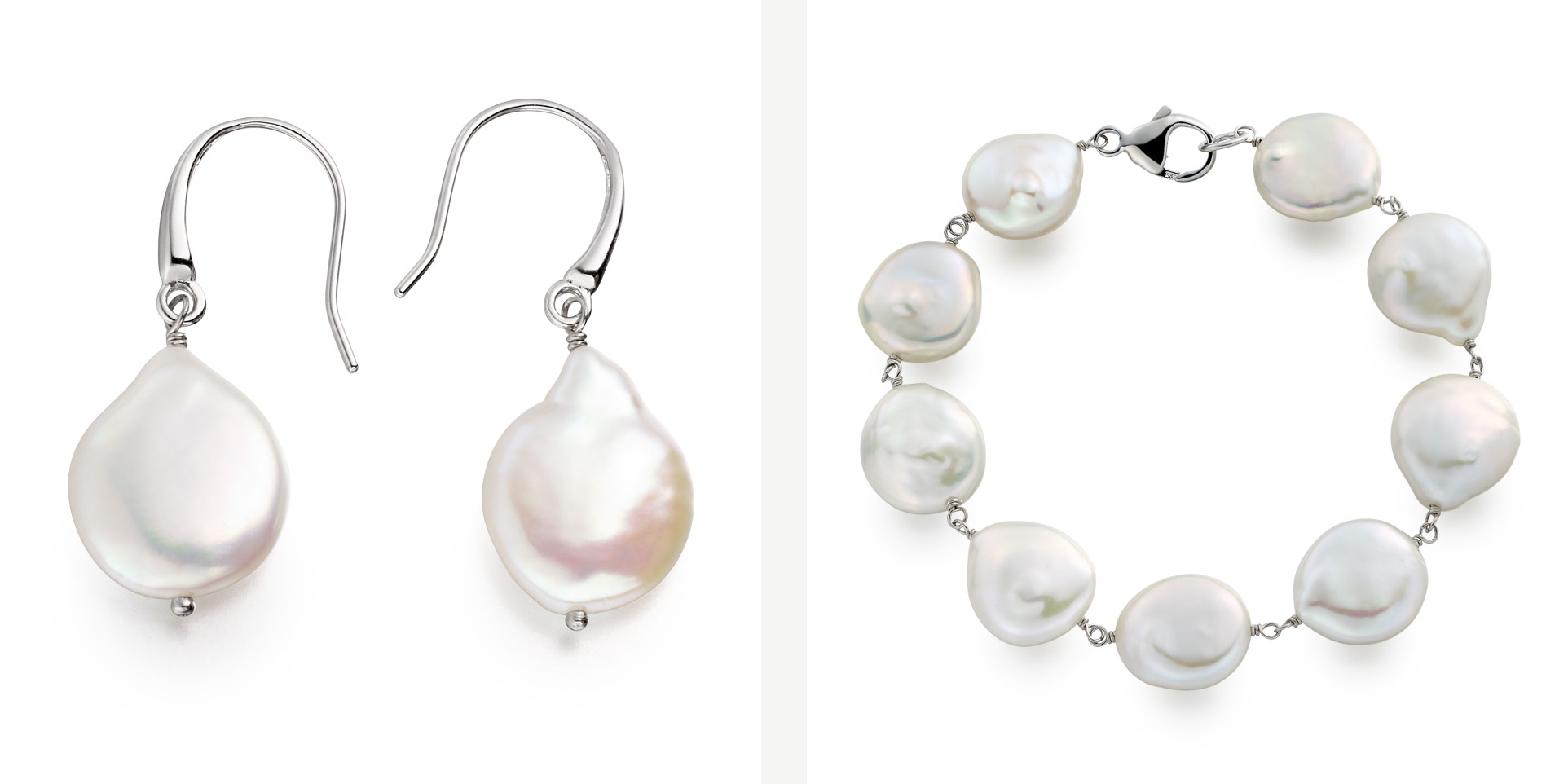
Image 1: Coin pearl earrings
Image 2: Coin pearl bracelet
The quality of coin pearls can vary significantly. When choosing a necklace or bracelet made from coin pearls, or a pair of coin pearl earrings, look closely at the quality of the nacre. If you can easily see the shape of the flat shaped nucleus within the pearl, it is likely that the pearl has been removed from the mussel too early and the thickness of the nacre is too thin. This may lead to dull lustre and the pearl may be prone to scratching or damage.
The highest quality coin pearls with a perfectly round shape, excellent nacre, excellent surface quality are sought after. They are typically bought and sold by specialist dealers.
We look for coins that have a thick coating of nacre. Often these pearls will have some shape or surface irregularities, such as flame-like tails or small bumps, but we love the way that these imperfections add to the character of the jewellery. Their flat shape will lie beautifully and comfortably around the neck.
If you are not familiar with pearls, view our collection of Freshwater pearl jewellery.